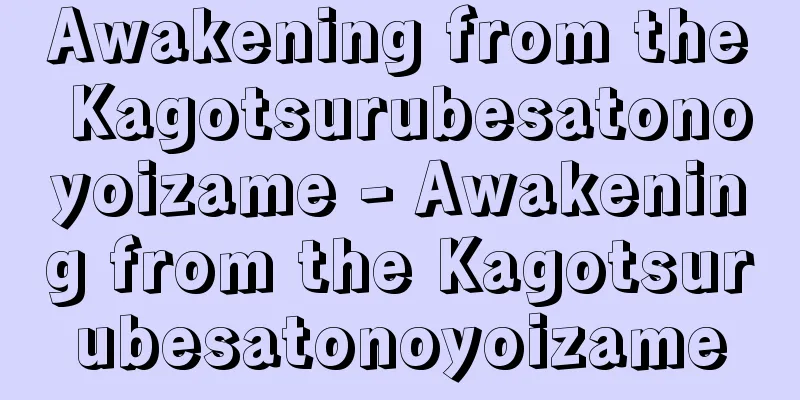Awakening from the Kagotsurubesatonoyoizame - Awakening from the Kagotsurubesatonoyoizame

|
A Kabuki play. A domestic drama. Eight acts. Written by Kawatake Shinshichi III. It premiered in May 1888 (Meiji 21) at the Chitoseza Theater in Tokyo, with Ichikawa Sadanji I's Jirozaemon and Nakamura Utaemon V's (then Fukusuke) Yatsuhashi. It is an adaptation of a kodan (traditional storytelling) story about the "Yoshiwara Hyakunin Giri" (slaying of one hundred people) incident in the Kyoho era (1716-1736). The title "Kago Tsurube" is the name of the Muramasa sword with which Jirozaemon kills Yatsuhashi, and means that it is so sharp that even water cannot be held against it. Currently, it is often performed in three acts, including "Nakanomachi Misome," the fifth act of the original, "Enkiri," the sixth act, and "Koroshi," the final act. Jirozaemon, a silk merchant from Sano, Yōshū, falls in love with the oiran Yatsuhashi as she is travelling through Edo's Yoshiwara, and after frequent visits to her, he tries to buy her freedom. However, Yatsuhashi is reprimanded by her lover Shigeyama Einojō, and leaves Jirozaemon in the presence of a full audience. Filled with grief and anger, Jirozaemon returns to his hometown, where he returns to Yoshiwara once again carrying his family's Muramasa sword, killing many people, including Yatsuhashi. The highlights of the story are Yatsuhashi's seductive laugh in "Sightseeing," and Jirozaemon's long dialogue in "Severing Enen," in which he expresses his resentment, starting with "I guess that's not much of a oiran..." Jirozaemon was a specialty of the first Nakamura Kichiemon, and was inherited by the 8th Matsumoto Koshiro (Hakuō) and the 17th Nakamura Kanzaburō, while Yatsuhashi was the signature piece of the 6th Utaemon. [Toshiaki Matsui] [Reference] |Source: Shogakukan Encyclopedia Nipponica About Encyclopedia Nipponica Information | Legend |
|
歌舞伎(かぶき)脚本。世話物。8幕。3世河竹新七作。1888年(明治21)5月、東京・千歳座(ちとせざ)で初世市川左団次の次郎左衛門、5世中村歌右衛門(うたえもん)(当時福助)の八ツ橋により初演。享保(きょうほう)(1716~36)の「吉原百人斬(ぎ)り」事件を講談から脚色。題名の「籠釣瓶」は、次郎左衛門が八ツ橋を殺す村正(むらまさ)の刀の名で、水もたまらぬ切れ味の意。現在では、原作の五幕目にあたる「仲の町見染め」、六幕目の「縁切り」、大詰の「殺し」の計3幕が多く上演される。野州佐野の絹商人次郎左衛門は、江戸吉原で道中姿の花魁(おいらん)八ツ橋を見染め、通いつめたあげく身請けしようとするが、八ツ橋は情夫繁山栄之丞(しげやまえいのじょう)に責められ、満座のなかで次郎左衛門に愛想づかしをする。悲憤の次郎左衛門は故郷へ帰り、家伝の村正の刀を携えふたたび吉原へきて、八ツ橋はじめ多くの人を殺傷する。「見染め」の八ツ橋の艶然(えんぜん)たる笑いと、「縁切り」の次郎左衛門の恨みを述べる「花魁、そりゃあんまり袖(そで)なかろうぜ……」以下の長台詞(ながぜりふ)が眼目。次郎左衛門は初世中村吉右衛門の得意芸で、これを8世松本幸四郎(白鸚(はくおう))と17世中村勘三郎が継承、八ツ橋は6世歌右衛門の当り芸であった。 [松井俊諭] [参照項目] |出典 小学館 日本大百科全書(ニッポニカ)日本大百科全書(ニッポニカ)について 情報 | 凡例 |
<<: Kirkcaldy (English spelling)
Recommend
Jinshin Agreement
These are the conditions for trade given by Korea ...
Gilgit Division
...The border with China on the Indian side remai...
Katsusaka ruins
This is the site of a large-scale settlement from...
Incapacitated person - munouyokusha
A person who cannot perform a legal act completely...
Tachometer - Tachometer
The speed of rotation is calculated by centrifugal...
Shinobu - Shinobu
[1] (Ta-ba-jo-ni) ① To suppress feelings. To avoid...
Political novel
Literature intended to enlighten political though...
Kakuju
...Three major roles of old women in Kabuki are s...
Obi fee - Obiryo
...In addition to the obi celebration in the fift...
Hugues
…Its official name is the Order of the Knights Te...
Standing - Tachimawari
1. To walk around from place to place. Also, to st...
Aichi River
A river in eastern Shiga Prefecture. The Chaya Riv...
Kirtan - Kirtan
…These are called prabandha. In the Bengal region...
Calceolaria corymbosa (English name) Calceolaria corymbosa
… [Eiichi Asayama]. … *Some of the terminology th...
General Free Person
...In the 19th century, this idea was combined wi...









